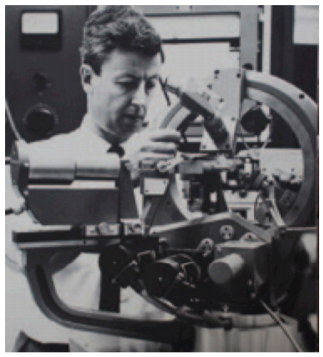- History Home
- People, Leadership & Service
- A Legacy of Excellence
- History & Impact
- Meetings Through the Years
- Resources
Obituary - Eric Gabe (1933 - 2020)Biography | Publications | Bibliography | Videos | Slides | Articles | Obituary
Remembrance of Eric Gabe (1933 - 2020)ACA RefleXions, Summer 2020
Jenny Glusker: Eric Gabe, a crystallographic colleague from Ottawa, Canada, died on 30 January 2020. It is with great sadness that I write about him. He was born in Cardiff, Wales, in July 1933 and studied at Cardiff University, obtaining a B.S. in 1957 and then a Ph.D. on 1960. This was an exciting time to be an X-ray crystallographer because the Patterson function and early direct methods had become available so that the determination of a crystal structure, which previously had taken years to accomplish, could now be done with much greater speed in most (but not all) cases. But there were still problems using the diffraction equipment, measuring intensities of X-ray diffraction data and calculating electrondensity maps. It was a very productive time as electronic computers were finally being used for the various stages of structure determination. Eric, a physicist, took part in all these aspects of the science and, through his lifetime, worked on improving each of them, particularly with an eye to automating diffraction equipment and data analysis. After his Ph.D. degree at Cardiff University Eric worked with William H. Barnes and Farid Ahmed at the National Research Centre of Canada in Ottawa. He then moved to England to work on a Ferranti Mercury machine, and then, in 1963, to Lindo Patterson’s laboratory in Philadelphia. This was where I got to know him. We worked together on a few of the same crystals when we both were in Patterson’s laboratory – a citrate, a hydrocarbon derivative and a copper-containing anti-tumor agent. Eric was a great colleague, providing friendly criticism when needed, and ensuring that good, precise results were obtained. In those days (the early 1960s) we were doing all computer analyses in Patterson’s laboratory on an IBM 1620 computer (which Eric, who had already programmed on IBM 650 and very large Ferranti Mercury computers, described as “a rather strange machine which used a decimal structure rather than binary”). Eric wrote many very useful programs for structure determination for those who had a 1620 computer, and these programs were distributed world-wide from Patterson’s laboratory. Then, in the mid-1960s, Eric moved on. He returned to The National Research Council of Canada in Ottawa, first automating a Picker diffractometer in the Department of Energy, Mines, and Resources and then, to the Chemistry Division, working with Yvon Le Page and several others on the NRCVAX package (described in J. Appl. Cryst. 1989). Programs were now written by him on the larger computers that had become available. As before he aimed to improve precision in data collection, to automate the machines involved, and to determine and analyze the crystal structures of a variety of compounds. His structural analyses included many copper derivatives and several compounds with very interesting reactivities (which he analyzed). I met Eric and his wife, Mo (Maureen), and two eldest children (Stephen, 2 years and Christopher, 3 weeks) when I was in England, on holiday in June 1963. Eric had applied for a position in Patterson’s laboratory in Philadelphia and I suggested that they should come there. They decided to do so and came in October 1963 and stayed with Don and myself at our home when they first arrived from England. So we got to know each other well and their children enjoyed playing with ours. Eric and Mo were then able to look for a house for themselves. I think they enjoyed life in Philadelphia and they went to the ACA meeting in Montana State College, Bozeman, MT in July 1964 and had a great time. These were good years. We saw several areas of science advanced as the three--dimensionality of so many nanostructures were being found. The joys of this were evident to many of us. Eric will be missed and I send sincere condolences to his wife, Mo, and his family.
Susan K Byram: It was with great sorrow that I learned of Eric Gabe’s death in Ottawa on January 30, 2020. Eric was a mentor and an inspiration when I was a budding software developer in a new job at the National Research Council (NRC) of Canada in Larry Calvert’s group in the Chemistry Division in Ottawa. Eric moved from the Department of Energy, Mines and Resources across town to join our group at NRC, inspiring us to contribute to his software suite for crystallographic structure analysis which eventually became the NRCVAX suite, still in use today. Eric was brilliant and funny and encouraging. He introduced me at ACA meetings to the wider world of crystallographers, most happily to Jenny Pickworth Glusker whom he knew from the A. L. Patterson lab in Philadelphia. According to his own history, found in the Canadian National Committee for Crystallography newsletter number 1, Eric moved to Ottawa to the Department of Energy, Mines and Resources in 1966. In 1972 he moved to the Chemistry Division at NRC where he began work on what became the NRCVAX package for crystallographic data collection and structure analysis, collaborating with Dr. D. F. Grant, Dr. A.C. Larson, Prof. Yu Wang and Dr. P.S. White. The system migrated to the DEC VAX in the mid-70s and later to PC’s using Windows.
Eric Gabe with Picker diffractometer controlled by DEC PDP-8 (circa late 1960’s)
|

